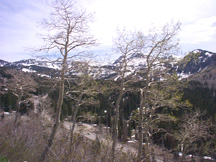Water Supply Update (5)
Below normal run-off and dry month of May continue water worries.
June 4, 2001
|
|
The flow at the Hailstone rating station peaked at 3,200 cubic feet per second at 1:45 a.m. on May 17, 2001, about a month earlier than normal. Currently Deer Creek Reservoir contains 134,800 acre-feet of water of which 25,000 belongs to the Central Utah Water Conservancy District and 4,000 to other third parties, leaving 105,800 acre-feet belonging to PRWUA for the water year. Approximately 18,000 acre-feet of water has been used from the supply by PRWUA shareholders. This leaves about 87,800 acre-feet of water available for the remainder of the water year.
Based on the water year supply of 105,800 acre-feet of water, the shareholders will receive a full allotment of water. The problem is that if the shareholders use the full allotment there will be no water carried over in the reservoir for next year to protect against another dry year. Normally there would be about 50,000 acre-feet of water after the full allocation to carry over for the next year -- not this year. This is what troubles Denos, who is recommending only an 80 percent allotment resulting in a 20,000 acre-foot reserve for next year. But it's up to the individual shareholders to make the decision.
The Metropolitan Water District of Salt Lake City (MWDSLS) owns 61.7 percent of the stock in PRWUA. It supplies wholesale water to member cities Salt Lake City and Sandy City and surplus water to the Jordan Valley Water Conservancy District.
MWDSLS is buying up to 4,000 acre-feet of spot market water to bolster the Deer Creek Reservoir supply. As of June 1, 2001 the two cities have drawn very little from Deer Creek Reservoir, by managing their resources and asking for conservation measures. Likewise, Salt Lake City has not used any water out of Little Dell Reservoir, opting to hold this water supply in reserve for later this summer. Little Dell is expected to fill to about one-half full with 10,000 acre-feet of water, 4,000 less than last year. The reservoir when full holds 20,500 acre-feet of water.
The projected run-off volume from the seven canyon streams east of Salt Lake appears to be about 75 per cent of normal, with the Parleys Canyon drainage lower. Moreover, the weather has not cooperated. "Mother Nature has not cooperated this spring. May is the second driest on record with 0.23 inches of precipitation," says Salt Lake City public utilities hydrologist Dan Schenck, "I have never seen streamflow patterns like this year."
|
|
The lower than normal run-off into Utah Lake affects the level of the lake. The level is 1.37 feet below compromise level. It is almost certain that the lake will be at a much lower level this fall. However, for this year there appears to be adequate water in the lake to provide water right holders a full allotment of water. Utah Lake is critical to farming within Salt Lake County and the source of water that Salt Lake City uses to complete exchange agreements that provides culinary water from Parleys, Mill Creek, Big and Little Cottonwood creeks.
Now that the run-off is nearly over, the lower than normal water supply projections made earlier this spring have come to fruition. The need to conserve water has not changed. Salt Lake City is requesting its customers not to water between 10 a.m. and 6 p.m. and to reduce their water use by 20 percent this summer.

